Cisco Crosswork Cloud Traffic Analysis Data Sheet
Available Languages
Bias-Free Language
The documentation set for this product strives to use bias-free language. For the purposes of this documentation set, bias-free is defined as language that does not imply discrimination based on age, disability, gender, racial identity, ethnic identity, sexual orientation, socioeconomic status, and intersectionality. Exceptions may be present in the documentation due to language that is hardcoded in the user interfaces of the product software, language used based on RFP documentation, or language that is used by a referenced third-party product. Learn more about how Cisco is using Inclusive Language.
Cisco Crosswork Cloud Traffic Analysis is a networking monitoring solution for enterprise and service providers. The solution captures, enriches, and analyzes network data to help service providers, web companies, and enterprises improve network performance, manage costs, gain visibility, and reduce downtime.
Your network can be complex and often unpredictable. Traffic from over-the-top applications, automated systems, malicious attacks, or variations from simple operational error can have unforeseen effects on traffic flows. Network operators need a scalable and insightful toolset to help them visualize and optimize traffic congestion at key points within their network.
Today’s network devices produce vast amounts of data both on statistics and flows. Operators need effective tools to consume and correlate this critical traffic data at scale and at low operational cost.
Part of the Crosswork Portfolio, Cisco Cloud Traffic Analysis addresses Traffic Analysis, Peering Prospecting, and Peering Engineering challenges by providing a comprehensive network view and analysis of traffic at network peering boundaries designed to visualize and optimize traffic flows.
Traffic Analysis is a hosted application that provides rich analysis, visualization, and optimization recommendations for network traffic flows. Traffic Analysis helps you understand the flow of traffic across key points in your network and is delivered as a scaled-out SaaS services. This allows day-zero deployment with feature sets that are always up to date, with very low ongoing maintenance requirements.
Traffic Analysis aggregates traffic flow data across multiple devices, giving operators a view of the traffic matrix across the whole network. It adds critical context to observed traffic flows based on the existing rich data sets of external routing data captured by Cisco Crosswork Cloud Network Insights. Now, operators can gain a deeper understanding of the origins of traffic flows on their networks, as well as the impacts of changes in external routing state and policy.
How does it work?
Traffic Analysis provides actionable recommendations for optimizing traffic at congested network edges. As the number of peering points expand in today’s distributed networks, delivering end-to-end traffic visibility at scale is a critical requirement for effective network optimization. This visibility allows network operators to drive manual or automated changes that are clear and easy to implement based on defined policies – throughout the network.
Traffic Analysis helps address key Enterprise and Service Provider customer challenges such as, “who should you peer with”, and “what changes can I make to better optimize traffic”?.
By extracting and managing huge amounts of data, operators can rapidly address and proactively avoid disrupting events and impending security threats. Traffic Analysis provides reliable, timely, and actionable intelligence about what’s happening in the network 24/7 to deliver premium networked experiences.
Cisco Crosswork Cloud Traffic Analysis offers a networking monitoring solution for complex enterprise and service provider networks. The solution supports both cloud and on-premises server, router, switch, and firewall hardware. The Cisco Crosswork Cloud Traffic Analysis solution captures, enriches, and analyzes network data to help service providers, web companies, and enterprises to improve network performance, manage costs, gain visibility, and reduce downtime.
Cisco Crosswork Cloud Traffic Analysis enhances the cloud-based platform by presenting up-to-date network traffic change information. It uses standards-based traffic flow protocols in combination with a cloud-native architecture to capture the state of your network’s congestion across aggregated entry points. A critical step in reducing the Mean Time to Resolution (MTTR) for network edge congestion issues is the identification of which nodes are congested and what traffic flows are causing the congestion.
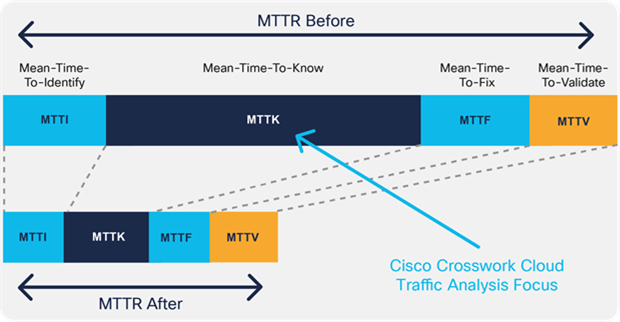
Mean Time to Resolution with Traffic Analysis
The Traffic Analysis features provide awareness of distributed congestion between multiple network elements at network boundaries. The platform differentiates itself by its ability to view the utilization state of multiple devices and identify what traffic is causing the congestion.
A multivendor solution, Traffic Analysis uses NetFlow, ASN, IPFix, and SNMP for traffic information awareness. Subscribers can analyze live and historical activity of the traffic matrix information for groups of network devices. Users can also quickly and easily identify what changes are required in order to better distribute traffic between multiple edge devices. This helps network owners maximize the capability of all assets during peak operating periods.
Network control protocols such as IGPs, ASN, RSVP-TE, and segment routing allow network operators to influence how traffic enters and exits internal routing domains. Network boundaries often have multiple entry points, making it difficult to continuously identify IP routes that can be manipulated to meet operational needs. The Traffic Analysis solution gives your organization the tools to identify and understand what changes need to be made to manage distributed congestion events at the edge of your networks. This subscription service significantly reduces the time it takes to know which edge devices are congested and what traffic is causing that congestion.
Crosswork Cloud Traffic Analysis removes the complexity and steps required for Enterprise or SP network operators or automation systems to quickly answer questions about short-lived edge congestion that cannot wait for hardware upgrades or significant changes to the network structure. Traffic Analysis improves performance and reduces operational costs of multi-homed internet connected networks.
By adding intelligence to routing changes, Traffic Analysis leverages existing network connectivity to deliver substantial network performance improvements, and a better return on investment.
Cisco Crosswork Cloud Traffic Analysis collects network data through a secure collection model and provides traffic data analytics to significantly reduce mean time to resolve edge congestion. Network operators can leverage the following initial capabilities:
● Real-time and historical visualizations of traffic matrixes for devices, device groups, and interfaces
● Alarms and notifications
● ASN and per-IP prefix traffic statistics
● Top-X traffic matrix table browser
● Flexible traffic dashboards and reports
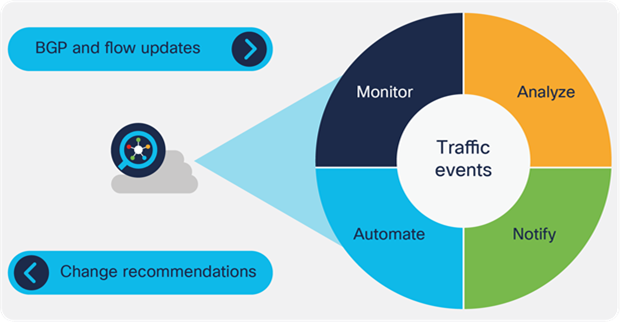
Key use cases
Continuous traffic event awareness and management
The Cisco Crosswork Cloud Traffic Analysis platform features continuous monitoring of traffic event workflow use cases:
● Independent monitoring traffic forwarding matrix information
● Monitor changing traffic flows to critical destinations inside and outside my network
◦ Monitor critical third-party traffic flows
◦ Monitor traffic flows to my hosted infrastructure
● Forensic combination of ASNand traffic flow update analysis
◦ Understand how route changes impact traffic capacity
◦ Identify which route events triggered specific traffic profile changes
● Traffic event search criteria
◦ Top-talker searches associated with ASN, Prefix, device, and interface groupings
◦ Utilization per Top-talkers based on ASN, Prefix, device, and interface groupings
Monitored IP route prefix and ASN traffic history
The traffic history enables the user to quickly identify IP prefix traffic events of importance. Events can be sorted and searched in various ways to quickly locate the root cause of a service impacting incident. Once an event is located, the detailed information for that event can be viewed as part of the next action. Subscribers will have different lookback periods based on the tier of subscription purchased.
Top talkers dashboards
The dashboard feature provides an immediate view of top-talker information for various edge network elements, including top transit and to/from ASNs as well as top prefixes and top devices. This view is the entry point into identification of which network segments are the most frequently consuming network elements.
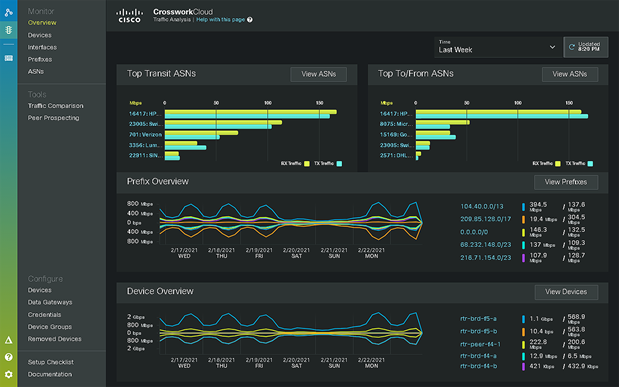
Top Talker Dashboard
Traffic matrix index search
The traffic search feature enables users to quickly locate specific prefixes or ASNs that are of interest based on the size and direction of flows and to then use these selections to graphically compare their traffic rates over time.
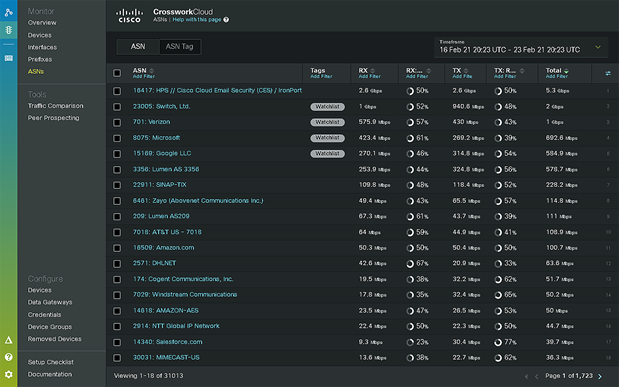
Traffic Search Feature
Device and interface traffic statistics
The time series traffic statistics feature shows the data rates for both devices and interfaces over a respective sample period. This can be useful to determine when specific traffic events occurred and use these time points. A user can further apply this information to quickly locate which IP route prefixes or ASNs are causing the event.
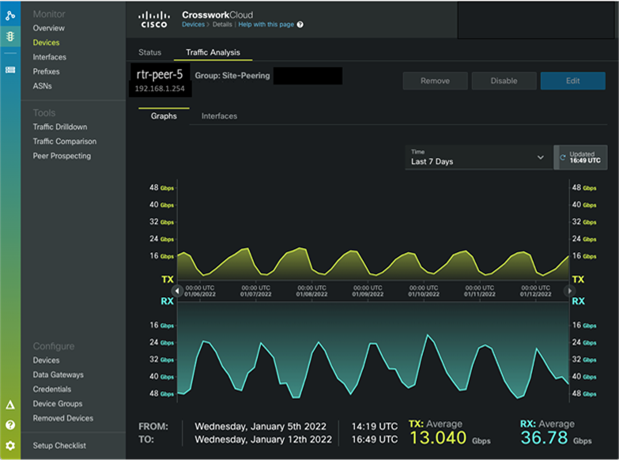
Time Series Traffic Statistics Feature
Traffic grouping view
When a number of items need to be compared over time, the user can group common items and compare their traffic profile over time. This feature can be beneficial when investigating traffic flows based on unexpected or disjoint groups of network objects. It can also be useful in matching flow capacities based on opposite directions, to better understand the impact based on direction through different places in the network.
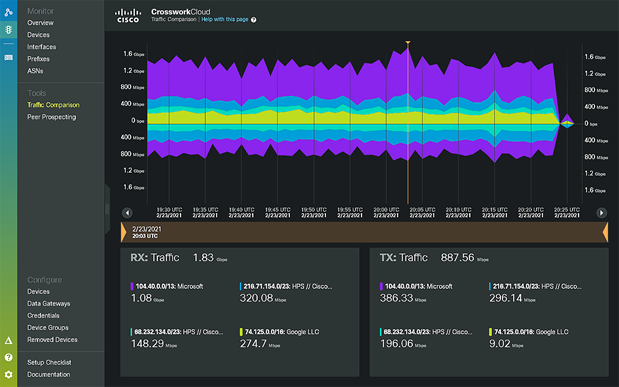
Traffic Grouping Feature
Table 1. List the main features and benefits of the Cisco Crosswork Cloud Traffic Analysis module
| Feature |
Benefit |
| Cloud Delivered |
Easy to order, provision, and set up Faster delivery of ongoing innovation Easier to integrate with other systems through APIs |
| Software as a Service (SaaS) |
Less technical and operational overhead needed to set up, operate, and maintain servers and software Ability to seamlessly add capacity, scale, and features, securely and reliably Frees you to focus on business objectives |
| Subscription Pricing |
Flexibility of payments, with 12- to 60-month terms and annual renewals Lower upfront Capex and overall Total Cost of Ownership (TCO) Ability to add capacity or term as needed to meet business requirements The current subscription tiers are:
● Essentials
Subscription tiers are based on the number of configured device routing devices to be monitored and the size of the device and the size of the device traffic forwarding capacity |
| Scale-Out On-Premises Traffic Collection |
Cloud Data Gateway is easy to deploy and manage and provides a consistent low-maintenance platform for cloud-to-ground connectivity and data collection. Designed to scale to multiple sites, these data gateways are 100% cloud managed and require little maintenance once deployed. Scaling collection is as simple as automating the deployment of new data gateways. |
| Traffic Reporting and Visualization |
● Route Prefix Analysis (Top X Src/Dst Prefixes)
● Route Prefix Group Analysis (Top X Src/Dst Prefixes by group)
● ASN Analysis (Top X Src/Dst Prefixes)
● ASN Group Analysis (Top X Src/Dst Prefixes by group)
● Device Analysis (Top X Src/Dst Prefixes)
● Device Group Analysis (Top X Src/Dst Prefixes by group)
|
| Data Learning Intelligence |
Provides deeper insight into event correlation and root cause analysis Enables machine learning methods to be applied to various data and event inputs Send threshold alarms to log-based event tools for deeper learning |
| API Framework |
Provides easy-to-use REST/JSON and gNMI APIs for all tasks The platform can be integrated into other SDN platforms Validate traffic change as part of an automation playbook Use policy events to trigger automation playbooks Configure traffic components, including
● Devices and Device Groups
● Interfaces and Interface Groups
● Prefixes and Prefix Groups
● ASNs and ASN Groups
|
| Multi-tenant |
Role-based access controls Cisco.com Federated One Identity for easy access to multiple customer tenancies Enterprise Single Sign-On with Federated Identity to reduce user support and onboarding |
| Network Automation Integration |
Trigger traffic balancing automation events using customizable criteria:
● Prefix Pre-change and Post-change State Checking
● Prefix Presence, Absence, Redundancy, and Coverage
● Prefix ASN Path Match Criteria
● Prefix ASN Community Match Criteria
● Prefix eBGP Segment Routing SID
Integrated options with Cisco Crosswork Portfolio solutions like Network Controller, Work Flow Manager, WAE and NSO. |
Products subscription tiers
Crosswork Cloud Traffic Analysis provides insight and analysis of traffic matrix information. The solution provides expanded near real-time and historical state information for each monitored IP routing device.
All Cisco Crosswork Cloud subscription tiers can be used independently or in combination with each other. The Traffic Analysis solution integrates the information and features of the Free license tier for Network Insights Exterior Route Analysis. Customers familiar with the Exterior Route Analysis solution can integrate their existing service offering of Cisco Crosswork Cloud Traffic Analysis or create a separate tenancy as required. Customers will be able to mix and match higher level license tiers based on allocation of tiered licenses to specific devices. License compliance is flexible and reported within the user interface.
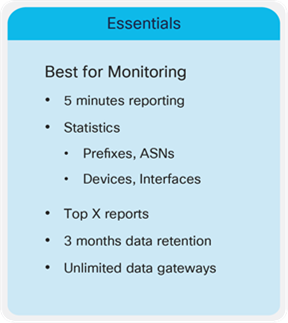
Crosswork Cloud Traffic Analysis Essentials Tier Benefits
The Cisco Crosswork Cloud Traffic Analysis application is delivered via a Software-as-a-Service (SaaS) offer and does not have any specific system requirements to operate the software itself. Users of the Cisco Crosswork Cloud products require one of the following browsers in order to access the SaaS application:
Table 2. Cisco Crosswork Data Gateway System Requirements
| Feature |
Description |
| Web Browser |
Google Chrome 70 or later |
| Mozilla Firefox 62 or later |
The Traffic Analysis features require the use of the Cisco Crosswork Data Gateway to aggregate device data and transmit this to the cloud service as a form of network telemetry. The following system requirements are a guide to a base collector Virtual Machine (VM) specification. The Cisco Crosswork Cloud application may require multiple CDG instances depending on the number of devices to be associated with the service and the amount of redundancy required from the collection framework.
For Cisco Crosswork Cloud applications, Cisco Crosswork Data Gateway software is included in your application cost. The Cisco Crosswork Data Gateway is prevented from being used for other on-premises Cisco Crosswork applications.
Table 3. Cisco Crosswork Data Gateway System Requirements
| Feature |
Description |
| Hypervisor |
VMware
● VMware vCenter server 6.7, ESXi 6.5
● VMware vCenter Server 7.0, ESXi 6.5 and 6.7
OpenStack
● OpenStack OSP16
Amazon
● Amazon Elastic Cloud Compute
|
| Memory |
32 GB minimum |
| Disk Space |
74 GB - Boot Disk 50GB + Data Disk 24GB(optional requirement) |
| vCPU |
8 vCPU |
| Network Interfaces |
Up to three virtual interfaces depending on requirements*
● One interface for management access, including SSH and GUI access to the VM. The DNS and NTP servers, and the default gateway, must be reachable via this interface.
● One interface for southbound device access. Associated devices must be reachable via this interface (routable).
● One interface for northbound cloud access. The data destination must be reachable via this interface (routable).
*Interfaces can be consolidated subject to deployment requirements.
|
For more information about the Cisco Crosswork Data Gateway, please see the Crosswork Data Gateway Data Sheet.
Cisco Crosswork Cloud Traffic Analysis is available. To order, please visit the Cisco Ordering Home Page.
Traffic Analysis feature tiers can be ordered in one-year, three-year, and five-year subscription periods. In addition, volume and term discounts are available for customers ordering higher numbers of monitored routers at the same time. There is currently only a license options Essentials features detailed above. More comprehensive license features will follow later. The SaaS software is accessible via crosswork.cisco.com.
Cisco Smart Accounts and Smart Licensing are supported for Traffic Analysis. In addition, Cisco Connection Online (CCO) user accounts are mandatory in order to use the Cisco Crosswork Cloud user interface.
Cisco environmental sustainability
Information about Cisco’s environmental sustainability policies and initiatives for our products, solutions, operations, and extended operations or supply chain is provided in the “Environment Sustainability” section of Cisco’s Corporate Social Responsibility (CSR) Report.
Reference links to information about key environmental sustainability topics (mentioned in the “Environment Sustainability” section of the CSR Report) are provided in the following table:
| Sustainability topic |
Reference |
| Information on product material content laws and regulations |
|
| Information on electronic waste laws and regulations, including products, batteries, and packaging |
Cisco makes the packaging data available for informational purposes only. It may not reflect the most current legal developments, and Cisco does not represent, warrant, or guarantee that it is complete, accurate, or up to date. This information is subject to change without notice.
Cisco offers a wide range of services to help accelerate your success in connecting to Cisco Crosswork. The innovative Cisco Services offerings are delivered through a unique combination of people, processes, tools, and partners and are focused on helping you increase operational efficiency and improve your network control. Cisco Advanced Services use an architecture-led approach to help you align your network infrastructure with your business goals and achieve long-term value. Cisco Crosswork products can be combined with the Cisco SMARTnet® service to help you resolve mission-critical problems with direct access at any time to Cisco network experts and award-winning resources. Spanning the entire network lifecycle, Cisco Services offerings help increase investment protection, optimize network operations, support migration operations, and strengthen your IT expertise. For more information, please visit www.cisco.com/go/services.
Flexible payment solutions to help you achieve your objectives
Cisco Capital makes it easier to get the right technology to achieve your objectives, enable business transformation and help you stay competitive. We can help you reduce the total cost of ownership, conserve capital, and accelerate growth. In more than 100 countries, our flexible payment solutions can help you acquire hardware, software, services and complementary third-party equipment in easy, predictable payments. Learn more.
For more information on Cisco's network automation portfolio please visit www.cisco.com/go/crosswork. To learn more about Cisco Crosswork or to schedule a demonstration contact your Cisco sales representative.
| New or Revised Topic |
Described In |
Date |
| General Availability |
January 10, 2022 |
|
| General Availability |
January 10, 2022 |
|
| General Availability |
January 10, 2022 |
|
| General Availability |
Crosswork Network Insights – Traffic Analysis – Data Sheet |
January 10, 2022 |